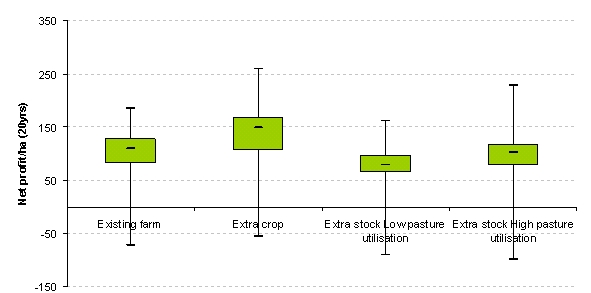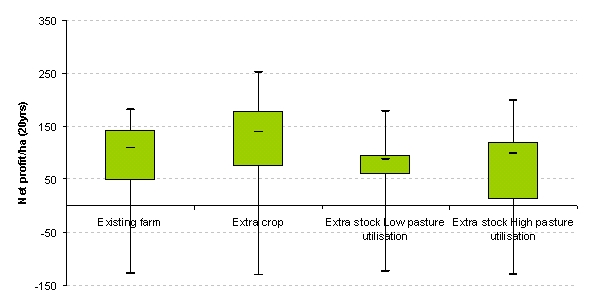Agronomy: the key to productive pastures that can sustain profitable grain production in Queensland
Author: David Lawrence & Brian Johnson, DAFF Queensland | Date: 16 Jul 2013
David Lawrence & Brian Johnson, DAFF Queensland
Take home message
Northern region growers estimate that ~30% of their cropping area has a significant soil health issue
Pasture phases and their contribution to boosting soil organic matter are a management option to address ‘soil health’ and maintain long-term grain production
The benefits from pastures are directly related to their productivity; poor pastures will limit beef production, and will do little to improve the soil and future crop production
Agronomic principles from grains are critical for better pastures that can sustain grain production
Introduction
Nearly 500 grain/cotton growers and advisers across the northern grains region participated in the ‘Healthy soils’ program funded by Land & Water Australia and GRDC. These growers and advisers estimated that 32% of the 2.5+ million hectares of cropping land that they managed had a significant soil health issue. The four biggest issues were; maintaining soil organic matter levels; getting water into the soil; maintaining a friable structure; and supplying adequate nutrients for crop production (Final Report LWA:QPI64, 2008).
Productive pasture phases can make a major contribution to these soil health issues in mixed farming areas. Productive grass-legume pastures will produce large amounts of dry matter to lift the soil organic matter levels for healthier soils that can supply more nutrients and maintain long-term productivity and whole-farm returns. However, to be effective, and profitable, these pastures must be managed well to maintain high productivity. A poor pasture will produce little beef; and may do even less for the health of your soils.
This paper provides a series of insights into the need to consider pasture phases in much of our cropping lands, the contributions these pastures can make; and the need for better agronomy to maximise these contributions and make them last. In short, how do insights from recent and ongoing GRDC supported project contribute to ‘what we all know’ about pastures and pasture phases in grain cropping systems? These insights may seem obvious, but it is good to revisit them with new data because “nothing is so often overlooked than what we take for granted.”
Grain cropping is more profitable than grazing cattle (Insight: for how long?)
People grow grain crops because they are considered more profitable that grazing enterprises. Increasing the area of cropping on a property, typically on the best soils, has increased net profit; while increasing the area of pastures led to lower profits (Figure 1). Even allowing for possible climate change by 2030, increasing the cropping area on a case study farm in the Maranoa district increased mean profits, albeit with more variability, while pastures produced lower profits with less variability (Figure 2).
Most, but not all, mixed farmers would agree with these general assessments of the profitability of their grain and grazing enterprises. However, soil fertility levels have been steadily declining and most grain farms have negative nutrient balances with overall removal of Phosphorus, Potassium, Sulphur and nitrogen continuing. Deficiencies that effect crop yields are becoming more common and fertiliser use will continue to increase as the natural fertility reserves of the soils decline. Growers’ fertiliser costs will increase as the soils’ organic and mineral fertility reserves falter.
Recent soil organic carbon measures across the northern region highlight the extent of this fertility decline and the extra costs of replacing nutrients that we have largely taken for granted. These nutrients must be replaced for a system that is sustainable for the long-term.

Figure 1. The Effect of increasing the area of grain or sown pastures (by 500 ha) on net profit for a grain/beef property (Brigalow soil, Maranoa) (Source: H Cox)

Figure 2. Impact of increasing the areas of grain or sown pastures (by 500 ha) effects on net profit (Grain/beef property on Brigalow soil, Maranoa; A1FI-H GFDL2.0 climate scenario for 2030. (Source: H Cox)
Paired comparisons of long-term cropping soils with adjacent paddocks that had been returned to pastures shows higher soil organic carbon measures under the pastures (Table 1). The differences in soil carbon levels ranged from 0 – 2.6 t Carbon/ha/year as the cropping paddocks continue to decline and/or the pasture phases start to rebuild soil organic matter and the associated soil nutrient reserves.
The average change in carbon stocks for the sites sampled to 30cm was ~1t/ha/yr organic carbon. These differences represent >$100 of nitrogen (or $150-200 for all nutrients) each year. These costs are rarely accounted for when we compare the profitability of cropping and grazing enterprises. When the soils’ natural nutrient reserves have declined to levels that require fertiliser rates that match removal, these costs may alter the relative profitability of different enterprises in mixed farming systems. Perhaps the greatest challenges will be retaining enough nutrient reserves to support healthy crops and pastures for flexibility in future enterprise decisions.
Pasture phases rebuild old cropping soils (Insight: If pastures are well managed and productive)
These pasture phases varied in their ability to rebuild old cropping soils (Table 1). The contribution of pastures phases to soil organic matter, and hence nutrients, depends on the productivity of the pastures; on how much dry matter they produce. The difference in carbon stocks from pasture phases tended to be greater in eastern areas where rainfall is higher, and where pastures contained legumes. Legumes can supply ~ 30 kg N/ha/yr to support extra grass growth. As such, legumes are critical and grain growers must maintain soil phosphorus levels to ensure adequate legume growth (e.g. Glenmorgan T58/59) and avoid running phosphorus down to levels at which legumes will not grow and overall pasture production is low (e.g. Condamine M95/95).
Table 1. Carbon stocks and annualised differences in carbon stocks in crop soil and adjacent paddocks that had been returned to pastures
|
Location |
Soil/vegetation |
Crop (in years) |
Pasture (in years) |
Carbon stocks (t/ha) |
∆ Carbon (t/ha/yr) |
|---|---|---|---|---|---|
|
Samples to 30 cm (0-10cm +10-30 cm) using conservative Bulk Densities of 0-10: 1.25 & 10-30: 1.3 |
|||||
|
Warra (SOC21/22) |
Brigalow Clay |
75 65 |
0 10 (sown grass/legume) |
26 52 |
+ 2.6 t/ha/yr |
|
McCallister (SOC62/63) |
Waco clay |
60 50 |
0 10 native grass |
44 54 |
+1 t/ha/yr |
|
Jandowae (SOC41/42) |
Brigalow clay |
40+ (inc baling) 40+ |
0 40 (sown grass) |
49 63 |
+0.4 t/ha/yr |
|
Nindigully (SOC1/2) |
Red box loam |
40 30 |
0 10 (sown grass) |
28 31 |
+0.3 t/ha/yr |
|
Nindigully (SOC5/6) |
Coolibah clay |
25-30 25-30 |
0 10 (sown grass) |
17 21 |
+0.4 t/ha/yr |
|
Samples to 10 cm only (2008-2011) using conservative Bulk Densities of 0-10: 1.25 |
|||||
|
Warra (J82/83) |
Brigalow clay |
45 35 |
0 10 (sown grass/medic) |
12 17 |
+0.5 t/ha/yr |
|
Glenmorgan (T58/589) |
Box wilga loam |
25 15 |
0 10 (sown grass/medic) |
8 20 |
+1.2 t/ha/yr |
|
Condamine (M93/94) |
Brigalow belah clay |
40 30 |
0 10 (sown grass/medic) |
15 25 |
+1 t/ha/yr |
|
Talwood (G24/25) |
Red clay |
40 40 |
0 7 (sown grass/medic) |
13 19 |
+0.9 t/ha/yr |
|
Talwood (G18/19) |
Brigalow clay |
15 15 |
0 3 (sown grass) |
14 18 |
+1.3 t/ha/yr |
|
Talwood (G28/29) |
Grey Clay |
25 15 |
0 10 (sown grass) |
9 13 |
+0.4 t/ha/yr |
|
Goondiwindi (G12/13) |
Brigalow belah |
30 30 |
0 20 (sown grass) |
16 20 |
+0.2 t/ha/yr |
|
Condamine (M95/96) |
Belah wilga |
35 20 |
0 15 (native) |
12 12 |
+0 t/ha/yr |
Pasture is an easy ‘low input’ option (Insights: Better agronomy and inputs will increase benefits)
Large areas of land across the western area of the northern region are cropped until fertiliser is required. These areas are often then returned to a pasture; either permanently, or to rebuild soils for re-cropping later. While legumes with adequate phosphorus can supply nitrogen and help maintain pasture growth, we know that grasses will typically produce an extra 30-35 kg dry matter for each additional kilogram of nitrogen we add.
Dramatic dry matter and quality responses from recent trials applying nitrogen to grass-based pastures raises the opportunity to rebuild soil more rapidly with higher input systems that use better agronomy. For example, urea applications on the Darling Downs in March 2013 show 50 -100% yield increases in just 4-6 weeks (Table 2). With typical feed quality increases of 2-4 % extra in protein contents as well, nitrogen applications may ensure better production and benefits in short-term pasture phases to rebuild soil organic matter in cropping systems.
Table 2. Dry matter response of grass pastures to applied urea on the Darling Downs (April 2013)
|
Pasture type |
Nitrogen rate (kg/ha) |
Dry matter |
|
|---|---|---|---|
|
(kg/ha) |
Extra |
||
|
Creeping bluegrass (Softwood scrub) 24 days growth |
0 |
4040 |
|
|
55 |
5990 |
48% |
|
|
Rhodes grass (Red box loam) 38 days growth |
0 |
2200 |
|
|
55 |
3670 |
67% |
|
|
110 |
5520 |
151% |
|
|
165 |
6400 |
191% |
|
The time taken to establish productive pastures is another constraint for many grain growers considering pasture phases. Pastures traditionally take up to a year to ‘hit their straps’ and this is time people can ill-afford to have out of production. While crop agronomy has progressed over recent years, many experienced grain growers do not apply these same agronomic principles (e.g. storing moisture, maintaining good nutrition and controlling weeds) to their pasture activities.
Agronomic advances like using disc-openers and precise depth control can improve the reliability of establishment, reduce the time to first grazing, and ensure maximum productivity for the 5-10 year life of a pasture phases. Despite receiving 30 mm of rain seven days after planting, trials established by planting pastures 25 mm deep into prepared seed beds ‘like a crop’ boosted the establishment of Bambatsi Panic by 80% , while Burgundy bean establishment was reduced by 20%. With good stored moisture these trial areas rapidly produced good dry matter levels and were ready for grazing within three months (Table 3).
Table 3. Dry matter production of grass and legume pastures taken three (3) months after planting on a brigalow clay soil at Chinchilla
|
Species treatments |
Dry matter yield (kg/ha) |
|
|---|---|---|
|
Surface sown (rain 7 days after) |
Sown into moisture (25mm deep) |
|
|
Bambatsi Panic only |
3134 |
3579 |
|
Bambatsi + Burgundy Bean (Grass component) [Legume component] |
3160 (1480) [1680] |
3915 (2228) [1687] |
Conclusion: better agronomy is important for grains and pastures
Cropping land must maintain adequate fertility to support productive crops and pastures. If cropping soils are not fertilised and become too degraded (e.g. deficient in nutrients such as phosphorus) before they are returned to pastures they will produce little beef and do less to rebuild soils for future cropping. There is huge scope to improve the agronomy and management of pasture phases that will benefit both the grains and beef enterprises of mixed farms.
Contact details
Dr David Lawrence
Department of Agriculture, Fisheries and Forestry, PO Box 102 Toowoomba 4350
Ph: 07 4688 1617
Email: david.lawrence@daff.qld.gov.au
Brian Johnson
Department of Agriculture, Fisheries and Forestry, PO Box 102 Toowoomba 4350
Ph: 07 4688 1339
Email: brian.johnson@daff.qld.gov.au
GRDC Project Code: DAQ00182; DAQ00163,
Was this page helpful?
YOUR FEEDBACK
